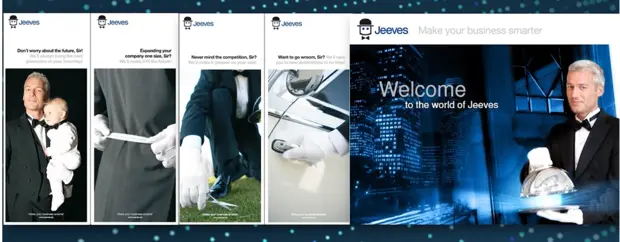A flexible and adaptable 30-year-old

1992 was an eventful year. It was the year when Sweden won the World Championship in ice hockey in Prague and many Swedes sat down in front of the TV to watch the premiere of Rederiet. Riksbanken, the central bank of Sweden, increased the policy rate to a staggering 500 percent for three days and Nirvana’s album Nevermind was released. For us at Jeeves, 1992 was the year when our first installations were made for our customers. A lot of things have happened in the past 30 years, and this is of course something we want to acknowledge.
Alla companies are unique
However, it all started with our founder Assar Bolin who realized that no company was like the other and therefore saw a need in the market for a flexible system to support them. So flexible it could be adapted to each company’s unique needs without having to change their way of working. This was an idea stretching the boundaries of that time and this was the foundation for Jeeves ERP.
The company Zeromation was born with Assar Bolin running it. After a slow start at the beginning of the 1990s, an explosion of Jeeves installations came before and after the millennium. The market was attracted to a new Swedish vendor choosing Microsoft as a base, offering the possibility to make adaptions to the systems, while at the same time promising that future upgrades would not affect these adaptations.
This is a promise we have kept throughout the years and Jeeves ERP is a highly flexible and adaptable system where adaptations are kept after upgrades.
Roughly around the same time as Assar Bolin started Zeromation, a group of future colleagues had started the development of another ERP system, Garp. They worked for a company called Mikrokraft but we will come back to them later.
Where does the name Jeeves come from?
The name is inspired by the British tv-series Jeeves and Wooster running in the early 1990s. The series is based on the books by P.G Wodehouse and is about Bertie Wooster and his well-read, quick-witted, and talented servant Jeeves. No wonder it was a suitable name for our ERP system.
In 1996 the company officially changed to name to Jeeves Information Systems and during the following years, our marketing went all in for the theme servant. The servant has been with us over the years and in our current logotype, created in 2018, it is shown as a bow.
Stock market successes and further growth
During 2002 and 2003 Jeeves was the only software company succeeding on the stock market in Sweden. IT index was down by -61 percent and the closest company in the list, Sectra, had at the time decrease of -13 percent. Jeeves at top of the list made an increase of +25 percent. While Jeeves succeeded in the stock market, the founders of Mikrokraft were looking for a long-term and strategic new partner to hand over Garp ERP to. Eventually, the decision was made that Jeeves acquired Microkraft. As colleagues instead of competitors it was possible to cover a larger part of the market together under the same management.
The next big step in our journey of growth was in 2012 when Battery Ventures from the USA acquired 98 percent of the company. At this time our group parent Forterro was founded. With Battery Ventures behind us, we gained the power to grow even more and the transition from an indirect software company to a full-service vendor began. The following year the next acquisition took place, this time it was our largest partner InfoCube. A successful merge where Jeeves’ strengths in product development were combined with InfoCubes’ strengths in implementation and customer development.
2014 our office in Bangalore India was opened and today there are approximately 70 colleagues working there. Jeeves is represented around the world both with customers and partners
Digitalization and creativity
In 2020 something happened that no one could have anticipated, from one day to another the world closed down due to the pandemic. The chairs in our offices were empty, and it would take almost two years before we could all meet each other and our customers again. In Sweden, we were not as affected by the lockdown as our colleagues in India, but we all had to adapt to home offices and digital Fika breaks instead. During this time, we learned that creativity and digitalization go hand in hand, and we found new ways of meeting and exchanging knowledge. We discovered among our colleagues’ future hosts presenting digital events such as Studio Garp and Jeeves Online Experience. We also invited our customers to over 40 webinars, something we are very proud of in hindsight.
Several hundreds of years of experience
Over the years many colleagues have passed through our company but there is still a loyal group of them left, some of them have been in the company for 20 years or more, and together they have more than 300 years’ worth of experience with Jeeves ERP. Many of our colleagues joining when Microkraft was acquired are still with us and when summarizing their competence, they hold more than 160 years of experience from Garp ERP. Impressive indeed.
What about the future?
But what does the future look like? Well, we are in the middle of the next phase of our development. In March 2021, Dean Forbes took over as CEO for Forterro, and the headquarters was moved from Austin in Texas, USA to London in the UK. Forterro is coming closer to its markets and the work of creating the foundation for the future has been initiated. With Partners Group as a new investor in 2022, our next journey is commencing and the expansion into the other Nordic countries is our next challenge.
With that, we would like to say happy birthday Jeeves and thank you to all of you for making these past 30 years possible, both colleagues and customers contributing along the way. We look forward to another 30 years in the ERP- business and all the exciting things to come.

Our first logotype (1997)

This is how our marketing looked in 1997

From newspaper Dagens Industri 10 January 2003